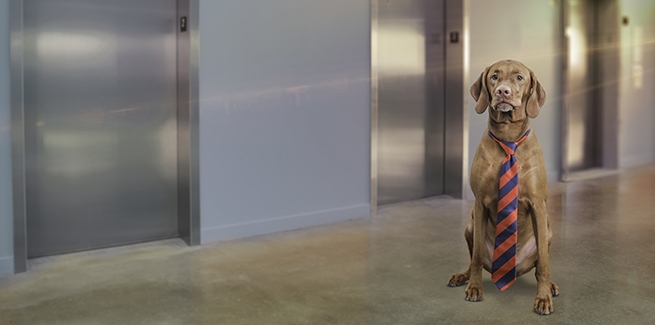Tomorrow is TYDTWDay

Dogs in the workplace are nothing new to people who work in animal hospitals.
But for a lot people, it’s a something that only happens once a year.
This Friday, June 22, is the twentieth annual Take Your Dog to Work Day (TYDTWDay).
It was created by Pet Sitters International in 1999 to celebrate what great companions dogs make, and to promote their adoption. TYDTWDay is always celebrated on the Friday following Father’s Day.
But don’t feel left out if you’re a cat lover. Cats are included, too. In fact, the entire week leading up to TYDTWDay, June 18–22, is Take Your Pet to Work Week, with felines getting a special nod on the Monday before (Monday, June 18, was Take Your Cat to Work Day). All pets are welcome at work during Take Your Pet to Work Week. (In theory anyway—a company might be entirely pet friendly but still take exception to the idea of an employee bringing in, say, a fully grown Asian water monitor.)
Although the idea of a special day for taking pets to work may have originated in 1999, corporate America didn’t really get on board with the idea until after the publication of a groundbreaking 2012 study conducted by researchers at Virginia Commonwealth University (VCU).
The study found that dogs in the workplace helped reduce stress in their owners and make work more satisfying for other employees with whom the dogs came in contact.
The researchers compared employees who bring their dogs to work, employees who do not bring their dogs to work, and employees who didn’t have pets by measuring their relative levels of stress, job satisfaction, and company loyalty.
According to the study, stress levels in all employees were lower on the days the dogs were present than on days the dogs were absent, and significantly lower in the employees who brought their dogs. As a whole, employees who had dogs at the office and those who didn’t had higher job satisfaction than average.
And dogs in the workplace also seemed to help employees bond. They were much more likely to approach one another and start a conversation when a dog was present, using the dog as a topic of conversation to break the ice.
More significantly, researchers observed employees who didn’t have a dog asking coworkers who did have a dog for permission to take the dog for a walk during breaks. That led to an increase in exercise for those employees who do not own a dog.
The researchers concluded that pets in the workplace could lead to a huge boost in employee morale, provide stress relief for dog owners and non-dog owners alike, and increase cooperation among coworkers.
In the years since the VCU study, more and more employers are coming around. According to a recent survey, 8% of employers permitted pets in the workplace in 2017, up from 5% in 2013, the year after the VCU study. For some with a large number of millennials on staff, it could be a smart, money-saving tactic: one survey showed that 71% of millennials would take a pay cut if it meant they could bring their pets to work every day.
A list of America’s most pet-friendly companies of 2018 include Tito’s Handmade Vodka in Austin, Texas, Harpoon Brewery in Boston, Massachusetts, and Glassdoor in Mill Valley, California. AAHA didn’t make the list, but it could have—on any given day, more than a dozen dogs and the occasional cat are sharing office space with their owners here at our headquarters in Lakewood, Colorado.
They’re all good dogs, and things stay surprisingly quiet.
Probably quieter than at the headquarters of Seattle-based Amazon: The online retail giant also allows employees to bring pets to work; on any given day, you’ll find 6,000 dogs running around their 8.1 million square foot corporate campus.
Boy, that’s a lot of conversation starters.
Photo credit: © pick-uppath



